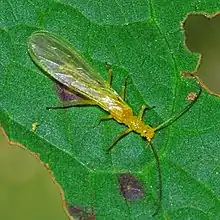Xanthoperla apicalis
Xanthoperla apicalis is a species of stoneflies in family Chloroperlidae.[2]
| Xanthoperla apicalis | |
|---|---|
 | |
| Adult of Xanthoperla apicalis | |
| Scientific classification | |
| Kingdom: | |
| Phylum: | |
| Class: | |
| Order: | |
| Family: | |
| Genus: | Xanthoperla |
| Species: | X. apicalis |
| Binomial name | |
| Xanthoperla apicalis (Newman, 1836) | |
| Synonyms[1] | |
| |
Subspecies
- Xanthoperla apicalis hamulata (Morton, 1930)
Distribution and habitat
This species is present in most of Europe (Albania, Belgium, Germany, Great Britain, Finland, France, the Netherlands, Italy, Norway, Austria, Poland, Romania, Sweden, Switzerland, Spain, Czech Republic, Slovakia, Lithuania, Hungary, Republic of North Macedonia, Ukraine).-.[3][4] These stoneflies occur in lakes, streams and wetlands.[5]
Description
Xanthoperla apicalis can reach a body length of about 5.5 mm (0.22 in) in males, of about 6 mm (0.24 in) in females, with a forewing length of { about of 6–.9 mm (0.236–0.035 in) in males and of 6.8–7.9 mm (0.27–0.31 in) in females. These small stoneflies have convex and protruding eyes and a rather narrow and long pronotum. The head is pale yellow, with black margins. Abdomen shows a relatively short dorsal dark. Legs are yellowish.[6]
Biology
This species of stoneflies has one generation a year (univoltine). Adults can be found from Spring to Summer, between May and July. Larvae have a carnivorous-detritivorous diet, while adults feed on pollen from angiosperms and pinaceae.[7]
Bibliography
- Claassen (1936) New Names for Stoneflies (Plecoptera), Annals of the Entomological Society of America (Ann. ent. Soc. Amer.) 29(4):622-623
- Morton (1930) Plecoptera collected in Corsica, by Mr. Martin E. Mosely, Entomologist's Monthly Magazine (Entomol. Mon. Mag.) 66:75-81 + 1 pl.
- Rambur (1842), Histoire naturelle des insectes: Neuroptéres., Librairie Encyclopédique de Roret, Paris i-vi, 1–534, 12 pl
- Stephens (1836), Illustrations of British entomology; or a synopsis of indigenous insects: containing their generic and specific distinctions with an account of their metamorphoses, times of appearance, localities, food and economy, as far as practicable, with coloured figures (from Westwood) of the rare and more interesting species, Baldwin & Cradock, London 6:134-145
- Kimmins (1970) A list of the type-specimens of Plecoptera and Megaloptera in the British Museum (Natural History), Bulletin of the British Museum (Natural History) Entomology (Bull. Br. Mus. Nat. Hist. Ent.) 24(8):337-361
- Claassen (1940) A catalogue of the Plecoptera of the world, Memoirs of the Cornell University Agricultural Experiment Station (Mem. Cornell agric. Exp. Sta.) 232:1-235
References
| Wikispecies has information related to Xanthoperla apicalis. |
| Wikimedia Commons has media related to Xanthoperla apicalis. |
- IRMNG
- Biolib
- Europaea
- Catalogue of Life
- PlecopteraSF: Plecoptera Species File
- Tierno de Figueroa, J.M.; Luzón-Ortega, J.M.; López-Rodríguez, M.J. 2016. Species Xanthoperla apicalis. (Newman, 1836). Iberfauna El Banco de Datos de la Fauna Ibérica. Museo Nacional de Ciencias Naturales (CSIC).
- name=iber/><ref Manuel Jesús López-Rodríguez, José Manuel Tierno de Figueroa, Tomáš Derka, Il’ja Krno The adult diet of Xanthoperla apicalis and Siphonoperla torrentium (Plecoptera, Chloroperlidae) in the Danube basin (Slovakia) Biologia 62(5):607-609 DOI: 10.2478/s11756-007-0119-z